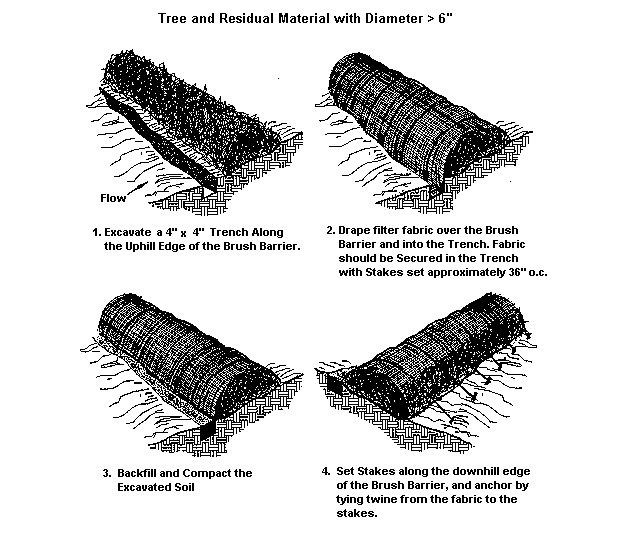Brush Barriers
Description
Brush barriers are a temporary sediment barrier constructed at the perimeter of a disturbed area, using residue materials (e.g., small tree branches, root mats, stone, or other debris left over from site clearing and grubbing). Brush barriers are used to trap and retain sediment from limited disturbed areas.
 Image Credit:
Image Credit: Virginia Department of Conservation and Recreation, Division of Soil and Water Conservation. 1992.
Virginia Erosion and Sediment Control Handbook, Third Edition. Virgina Soil and Water Conservation Commission.
Where Practice Applies
Below disturbed drainage areas of less than 0.25 acre per 100 feet of barrier length. The drainage slope leading down to a brush barrier must be no greater than 2:1 and no longer than 100 feet. This practice is not intended for areas of concentrated flow or substantial amounts of sheet flow.
Advantages
- Brush barriers can often be constructed using materials found on-site.
Planning Considerations
Organic litter and spoil material from site clearing operations is usually hauled away to be disposed of elsewhere. Much of this material can be used effectively on the construction site itself. During clearing and grubbing operations, equipment can push or dump the mixture of limbs, small vegetation, and root mat along with minor amounts of soil and rock into windrows along the toe of a slope where erosion and accelerated runoff are expected. Because brush barriers are fairly stable and composed of natural materials, maintenance requirements are small. Material containing large amounts of wood chips should not be used because of the potential for leaching from the chips.
Design Recommendations
- Height - 3 feet maximum.
- Width - 5 to 15 feet at base.
- Filter fabric anchored over the berm will enhance its filtration capacity.
Maintenance
Brush barriers generally require little maintenance. Heavy deposits of sediment may need removal. Occasionally, tearing of the filter fabric may occur. When the barrier is no longer needed the fabric can be removed to allow natural establishment of vegetation within the barrier. The barrier will rot over time.
References
Washington State Department of Ecology, Stormwater Management Manual for the Puget Sound Basin, Olympia, WA, February, 1992.
Virginia Department of Conservation and Recreation, Division of Soil and Water Conservation. Virginia Erosion and Sediment Control Handbook, Third Edition, Richmond, Virginia, 1992.